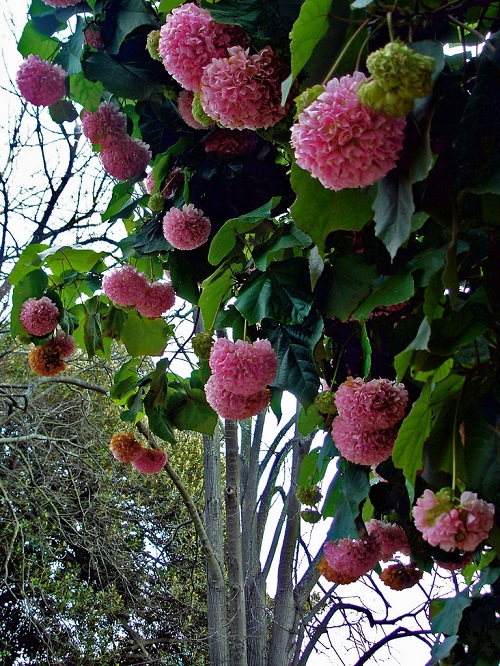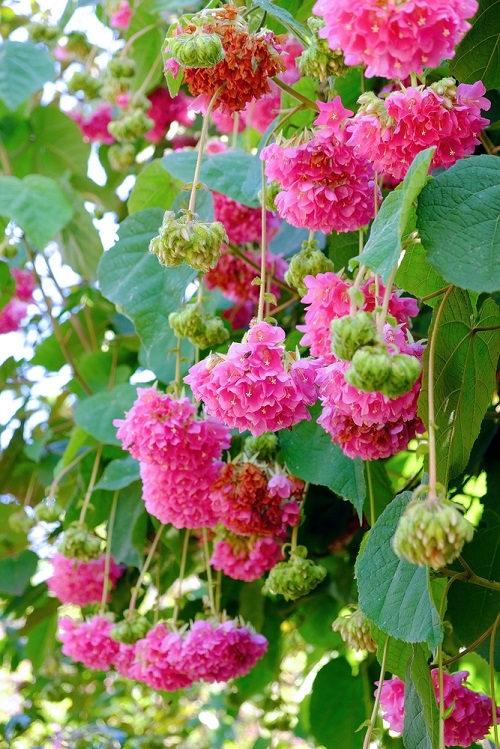Pink Snowball Tree can be a fantastic addition to both gardens and containers, thanks to its round clusters of flowers!
From promoting vibrant blooms to managing pests, this article will guide you in growing Pink Snowball Tree with expert care tips.
Explore Red Custard Apple Tree Care and Growing Information here
Pink Snowball Tree Information
The Pink Snowball Tree is a captivating ornamental shrub that belongs to the Adoxaceae family. Native to Europe and Northern Asia, this charming plant is a favorite among garden enthusiasts for its stunning appearance and attractive features.
The Pink Snowball Tree showcases its beauty through large, round flower clusters that resemble fluffy snowballs. These clusters comprise numerous tiny pink flowers, which give the plant its distinctive name. These blooms appear in late spring to early summer, creating a mesmerizing spectacle in gardens and landscapes.
When cultivated outdoors, the Pink Snowball Tree can reach a height of around 8 to 12 feet (2.4 to 3.7 meters) with an approximate width of 10 to 15 feet (3 to 4.6 meters).
One of the unique features of the Pink Snowball Tree is its ability to produce berries. After the blooms have faded, the plant develops attractive clusters of red berries that persist into the fall, providing food for birds and wildlife. This adds to its ecological value and adds an extra element of interest to the landscape.
Botanical Name: Dombeya wallichii
Explore King Palm Tree Care and Best Varieties
Propagating Pink Snowball Tree
Here are the methods to propagate the Pink Snowball Tree:
- Softwood Cuttings
- Hardwood Cuttings
- Layering
- Division
- Seed Propagation
The easiest method to propagate the Pink Snowball Tree is through Softwood Cuttings.
- Choose Healthy Shoots: Look for young, healthy shoots that are still flexible and haven’t fully matured. These are usually found at the tips of the branches. Avoid using old, woody stems.
- Prepare the Cuttings: Using sharp gardening shears or pruners, cut a 4 to 6-inch (10 to 15 cm) section of the softwood shoot just below a node (the point where leaves emerge). Remove any leaves from the lower half of the Pink Snowball Tree cutting, leaving only a few leaves at the tip.
- Plant the Cuttings: Fill small pots or containers with a well-draining potting mix. Insert the cut end of the softwood cutting into the soil, burying about half of the cutting. Gently press the soil around the cutting to hold it in place.
- Create a Mini Greenhouse: To maintain high humidity around the cutting, cover each pot with a clear plastic bag or plastic wrap. This creates a mini greenhouse effect that helps prevent moisture loss.
- Provide Light and Water: Place the pots in a location with bright, indirect light. Keep the soil consistently moist but not waterlogged. You can water the cuttings from the bottom by placing the pots in a shallow tray of water until the soil surface feels moist. Alternatively, mist the cuttings regularly to maintain humidity.
- Monitor and Wait: Monitor the Pink Snowball Tree cuttings over the next several weeks for signs of new growth. Once you see new leaves developing, it indicates that the cuttings have rooted and are ready for gradual acclimatization to normal conditions.
Propagate Any Plant Cutting Quickly Using this Trick
Best Pot Size for Planting Pink Snowball Tree
For growing Pink Snowball Tree in a container, start with a 12 to 18 inches diameter pot. Opt for a sturdy material like glazed ceramic or plastic. As it looks so beautiful, you can also grow it in large wooden or wine barrels to enhance the display!
Ensure the pot has drainage holes to prevent waterlogging, promoting root health.
Requirements for Growing Pink Snowball Tree

Location
The Pink Snowball Tree needs around 6-8 hours of indirect sunlight daily for optimal growth. Morning sunlight is gentle and preferred, while harsh afternoon sun should be avoided.
Indoor plants do well near south or west-facing windows. Monitoring light levels regularly ensures vibrant blooms and healthy foliage.
Soil
Create an ideal soil mix for the Pink Snowball Tree by blending well-draining garden soil, compost, perlite, and peat moss. Include well-rotted manure for nutrients and sphagnum moss to retain moisture.
The ideal soil pH range for the Pink Snowball Tree is slightly acidic to neutral, typically around pH 6.0 to 7.0. This pH range provides the right balance of nutrients and allows the plant to absorb essential elements effectively.
Check out Beautiful Trees with Yellow Flowers here
Water
Water Pink Snowball Tree evenly to keep the soil consistently moist, especially during the growing season. Avoid overwatering to prevent root rot.
Apply a layer of mulch to retain moisture and regulate soil temperature. Adjust the watering frequency based on weather conditions and soil moisture levels.
Temperature and Humidity
Pink Snowball Tree thrives in temperate climates with moderate temperatures and humidity. They prefer temperatures between 60°F to 85°F (15°C to 28°C), avoiding extreme heat or cold.
Adequate humidity helps prevent leaf drying. Protect from frost in colder months. Maintain a balanced environment for optimal growth and vibrant pink blooms.
Pink Snowball Tree Care

Fertilizer
Choose a balanced, slow-release fertilizer that provides a good mix of essential nutrients. Look for fertilizers labeled with an NPK ratio close to 10-10-10 or 14-14-14.
- Spring Fertilization: Apply the fertilizer in early spring, just as new growth begins. Spread the fertilizer evenly around the base of the Pink Snowball Tree, keeping it away from the trunk to avoid burning.
- Summer Fertilization: If your Pink Snowball Tree shows signs of slow growth or lackluster flowering during the summer months, consider a light application of water-soluble fertilizer. Apply according to package instructions, and water thoroughly after application.
- Fall Fertilization: In late fall, after the tree has dropped its leaves, apply a phosphorus-rich fertilizer with a lower nitrogen content. Phosphorus aids in root development and prepares the tree for winter.
Note: While it’s important to provide adequate nutrients, overfertilization can harm the Pink Snowball Tree. Avoid excessive use of fertilizer, as this can lead to nutrient imbalances, burning of the roots, and increased susceptibility to diseases.
Check Stunning Trees with Pink Leaves here
Pruning
Prune Pink Snowball Tree after flowering in late spring or early summer. Remove dead or diseased branches, and shape the plant for better airflow and aesthetics.
Avoid heavy pruning, as it may reduce next year’s blooms. Regular light trimming maintains its form and encourages healthy growth.
Pests and Diseases
Pink Snowball Tree can be susceptible to aphids, scale insects, and powdery mildew. Aphids and scale insects damage leaves, while powdery mildew causes a white, powdery growth.
Prevent pests through regular inspections and horticultural oil sprays. Adequate spacing, good air circulation, and proper watering can reduce disease risk.
Discover How to Grow Quince Fruit in a Pot here
Frequently Asked Questions (FAQs)
Q1: Can I plant my Pink Snowball Tree in full sun?
A: Pink snowball trees prefer partial to full sun, but they can tolerate some shade. Plant them in a location that receives at least 4-6 hours of sunlight per day for optimal flowering.
Q 2: Are Pink Snowball Trees deer-resistant?
A: Pink snowball trees are generally considered deer-resistant due to their texture and scent. However, deer might still nibble on them in extreme food scarcity.
Q3: Are there any specific winter care tips for Pink Snowball Trees?
A: Provide a layer of mulch around the base of the plant before winter to protect the roots from frost. Avoid late-season fertilization, as this can stimulate new growth susceptible to cold damage.



